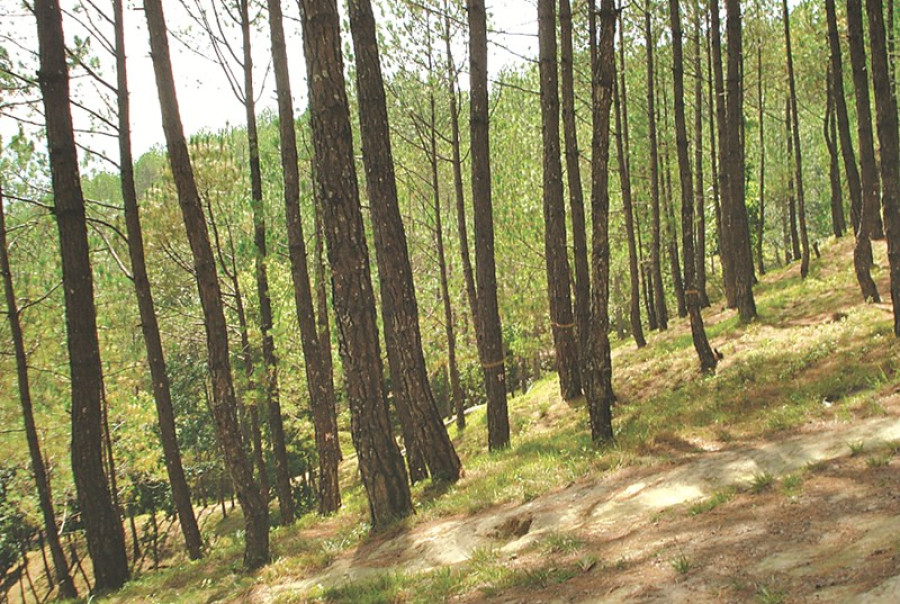Opinion
Deep roots
Though Chir pine was planted with a noble objective, little did people know about its fatal consequences
Imagine a tree. What do you see? Lush green leaves? Cool and relaxing shades? Mouth watering colourful fruits? Generally trees are considered to be the epitome of natural beauty and healthy environment. What if someone declares that tree plantation could be harmful to our environment? Will people accept such a fact? Probably not. The person making such a claim is likely to be a subject of ridicule. But such a scenario is possible.
Nepal has been promoting tree plantation and conservation mainly to support livelihood and conserve biodiversity. Nepal experienced massive deforestation from 1950s to 1970s. Therefore, in late 1970s, communities attempted to reestablish their lost forest resources in the barren hilly regions of Nepal. A special forestry programme known as “Nepal-Australia Forestry Project” was then initiated. Pinus roxburghii or ‘Chir pine’ (which is known locally as Khote salla) was chosen as one of the prime tree species for this reestablishment programme. Chir pine was selected because of its high survival rate and for the ease of its establishment. Though Chir pine was planted with a noble objective, little did people know about its fatal consequences.
Slowly, after a decade or two, people started to witness the scenario of drying water resources in the area of pine plantation. Gosaikunda Community Forest of Kavre district could be taken as an example where water resources are drying up. The residents living near Gosaikunda forest complained about water depletion after the growth of pine trees. Likewise, an experimental study known as thermal dissipation method was conducted in the Gosaikunds forest to measure pine water use. The study revealed that a single pine tree on average uses 13.5 liters of water per day. Depending on the tree size, the figure of up to 70-80 litres per day was recorded during noon when the temperature was more than 20 degrees Celsius. The study also demonstrated that bigger Chir pine trees consumed more water than the smaller sized ones.
It is not only the water sources that are being affected in the pine stand. Even the soil experiences a similar fate. Strong to moderate acidity was observed in the soil in Gosaikund forest. This high level of acidity in the soil is likely to prevent the growth of several diverse plant species in the area. The acidic bed rock of the area could be one of the factors behind the acidic nature of the soil. However, deposition of fresh pine needles may contribute to soil acidity to a certain extent. The possibility of dire consequences brought about by pine needles cannot be ruled out.
In the area with high dominance of the pine trees, other species rarely grow well. High acidic nature of soil signifies the presence of less diverse micro organisms in the soil. Smaller population of the soil microorganisms means lesser decomposition of the organic matter, which may affect the fertility of the soil. Fewer microbes could be the reason behind the low soil organic level in the Chir pine forest of Kavre district. Pine needles take a longer time to decompose than other broad leaves. Such slow decomposition is likely to be inefficient in improving soil fertility.
After witnessing the adverse impacts of the pine stand, the user group of Gosaikund Community Forest is now attempting to replace pine with Chilaune (Schima wallichii) and Utis (Alnus nepalensis). Though the users are unsure about the impacts of these two species, they perceive Schima and Alnus to be more suitable than pine. In future, the users are likely to establish more diverse broad leaves plant species to form a heterogeneous forest.
Afforestation and reforestation could be quite favorable and affirmative steps in terms of livelihood options. Yet, it is equally significant to assess the characteristics of any plant species before they are introduced in new areas. It is important that we learn lessons after witnessing the fate of pine tree plantation. Since plants, soil, air and water are linked to one another, it is essential to analyse these natural elements and their inter-linkages. Therefore, more forestry research should be carried out along with the monitoring of various natural elements such as soil, water and vegetation that depend on one another.
Shrestha is a researcher at Institute for Social and Environmental Transition-Nepal. She can be contacted at [email protected]




 13.12°C Kathmandu
13.12°C Kathmandu








%20(1).jpg&w=300&height=200)

